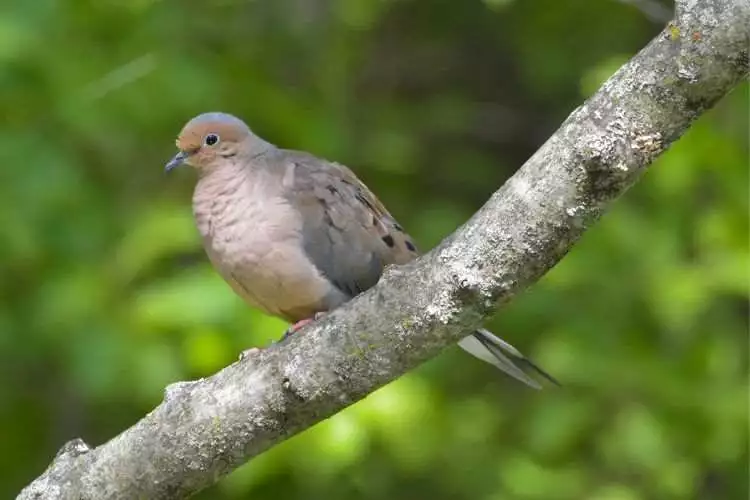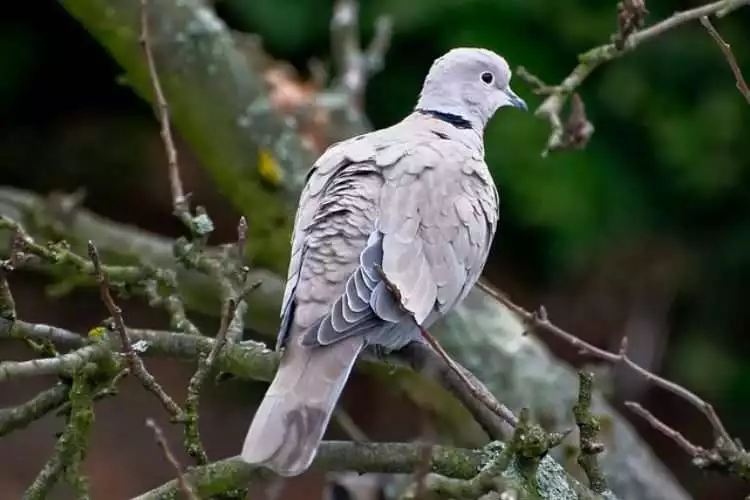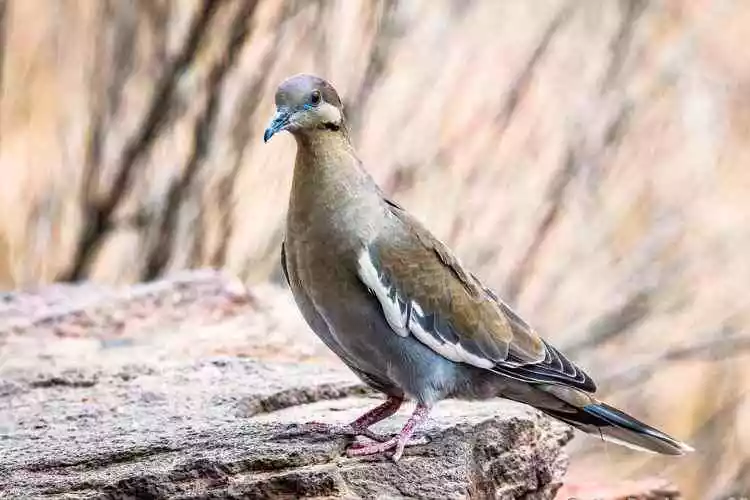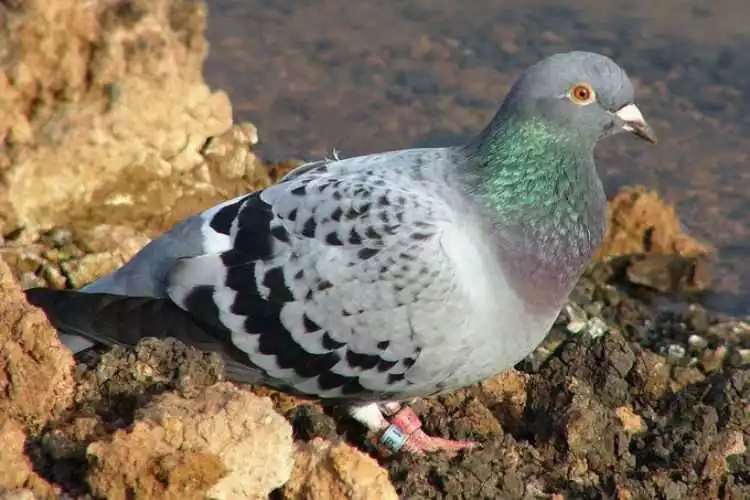Doves are common in Kansas and come in five types: mourning doves, Rock Pigeons, Eurasian collared doves, white-winged doves, and ringed turtle doves.
Mourning doves are small, brown birds that make a sad sound. They live in various places.
Eurasian collared doves are bigger and have gray-brown bodies with black collars. They are seen in cities and fields and are known for their loud cooing.
White-winged doves visit Kansas in spring and fall. They are large, grayish-brown birds with white on their wings. They make whistling sounds and live in open areas.
Ringed turtle doves are rare in Kansas, small, brown, and have black neck rings. They coo softly and live in wooded areas near water.
Doves are important in Kansas because they help control bugs, feed other animals, and bring beauty to the state.
Types of Doves in Kansas
Five species of doves in Kansas can be found: the mourning dove, the Eurasian collared dove, the white-winged dove, the rock dove, and the ringed turtle dove.
- Mourning Dove
- Eurasian Collared-dove
- Ringed Turtle-dove
- White-winged Dove
- Rock Pigeon
Let’s explore their habits, habitats, diet, behavior, migration, where to find, etc.
1. Mourning Dove

Mourning Doves are the most common doves in Hawaii, Kansas, Florida, California, and Michigan as well as in other parts of America.
Mourning doves are small types of dove species. They are brownish-gray birds commonly found in Kansas. They are about the size of your hand and have a gentle, mournful cooing sound.
Where You’ll Find Them: You can spot them in many places across Kansas, from fields and gardens to suburban areas. They often sit on power lines or peck around the ground for food.
What They Eat: Mourning doves mostly eat seeds, like those from sunflowers and wheat. They are helpful for farmers because they eat weed seeds, which is good for crops.
Family Life: These doves are fast breeders. They build simple nests in trees or on ledges. They can have babies multiple times in one season.
Travelers: Some stay in Kansas all year, but others fly south for the winter and return in the spring.
Why They Matter: Mourning doves are essential because they control insects and spread plant seeds. They’re also a popular bird for hunting.
You can also find these beautiful doves in Connecticut.
Mourning doves are a common and important part of Kansas’s wildlife, making our state more beautiful and balanced.
2. Eurasian Collared-dove

The Eurasian collared dove also known as a Eurasian immigrant to Kansas. This is a bird that is larger than the mourning dove. You can also find these doves in Colorado.
It has a grayish-brown body and a distinct black “collar” marking on its neck.
Where They Live: Eurasian collared doves are often seen in urban areas and agricultural fields across Kansas.
Sounds They Make: These doves are known for their loud and continuous cooing sounds, which they use to find mates and protect their territory.
Migration Patterns: Unlike some other doves, Eurasian collared doves don’t migrate. They stay in Kansas throughout the year.
Why They’re Important: These doves contribute to the birdlife in Kansas and have adapted well to our environments. Their calls are a familiar sound in many parts of the state.
Eurasian collared doves are a unique addition to Kansas’ bird diversity and have become a regular part of our landscape.
3. Ringed Turtle-dove

The ringed turtle dove is a small type of dove. It is a brown bird with a distinctive black ring around its neck. They are not very common in Kansas, but when spotted, they’re a special find.
Where They’re Found: Ringed turtle doves tend to live in wooded areas and near water sources. They prefer quieter places compared to busy urban areas.
Sounds They Make: These doves have soft, gentle cooing calls that are interesting to hear.
Unusual Visitors: In Kansas, ringed turtle doves are considered rare compared to other dove species. They’re not frequently seen but can be found in specific spots.
Ringed turtle doves are unique and charming birds that occasionally grace the natural landscapes of Kansas. When you do spot one, it’s a delightful sighting.
4. White-winged Dove

The white-winged dove is a larger bird with grayish-brown feathers and distinctive white patches on its wings. They’re migratory, meaning they visit Kansas during certain times of the year.
When They Visit: White-winged doves typically come to Kansas during the spring and fall as they migrate. So, they’re not here all year round.
Where You’ll Find Them: These doves prefer open fields and woodlands, making these areas their temporary home during their visits.
Sounds They Make: While in Kansas, you might hear their graceful whistling calls, which add a unique sound to the local bird chorus.
Migration Visitors: White-winged doves are like seasonal guests, enriching Kansas’ bird diversity during their stay.
White-winged doves bring a touch of variety to Kansas with their distinctive appearance and whistling calls, but remember, they’re not permanent residents.
5. Rock Dove

Rock Pigeons are highly common doves in Colorado as well as Kansas. This dove is large that’s why everyone calls them a “Pigeon”.
Rock pigeons are also known as common pigeons. This species of doves are adaptable birds that can be found in urban areas, including various parts of Kansas.
Urban Dwellers: Rock pigeons are frequently seen in cities and towns, where they’ve made buildings, bridges, and city parks their homes.
You can easily find these doves in Delaware.
Colors and Looks: They come in various colors, but the most familiar ones are gray with iridescent patches on their necks. They have a plump appearance.
Distinct Features: One noticeable feature is their cooing call, which is a common sound in urban areas.
Abundant and Familiar: Rock pigeons are some of the most common birds you’ll encounter in cityscapes, and they’ve adapted well to human environments.
These birds are also known as city birds. They are a familiar and interesting part of the wildlife you can find in Kansas, especially in urban settings.
FAQ
1. What are the four species of doves that are native to Kansas?
The four species of doves that are native to Kansas are the mourning dove, the white-winged dove, the Eurasian collared dove, and the ringed turtle dove.
2. What is the most common species of dove in Kansas?
The most common species of dove in Kansas is the mourning dove. It is found throughout the state and is a small, brown bird with a pointed tail.
3. When is the dove hunting season in Kansas?
The dove hunting season in Kansas is from September 1 to October 31. The daily bag limit is 15 mourning doves and 10 white-winged doves.
4. What is the limit on turtle doves in Kansas?
There is no limit on Eurasian collared or ringed turtle doves, but any taken in addition to the mourning and white-winged dove daily bag must have a fully-feathered wing attached while being transported.
5. What are some of the threats facing doves in Kansas?
Some of the threats facing doves in Kansas include habitat loss, climate change, and hunting. Habitat loss is a major problem for doves, as they need open areas with trees and shrubs for nesting and roosting. Climate change is also a threat, as it is causing changes in the availability of food and water for doves. Hunting is a legal activity in Kansas, but it is important to practice responsible hunting and to only take the legal limit of doves.
Conclusion
The dove is a beautiful and graceful bird that is a welcome sight in Kansas. It is a symbol of peace, love, and hope, and it reminds us of the beauty of nature. Doves play an important role in the Kansas ecosystem, and they are a popular game bird. We should all do our part to protect these amazing creatures.

